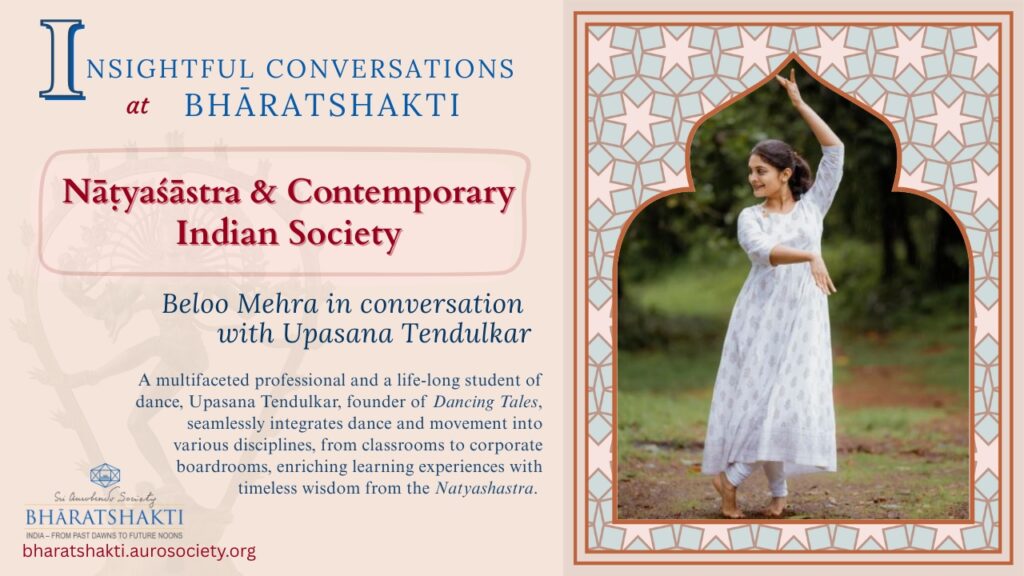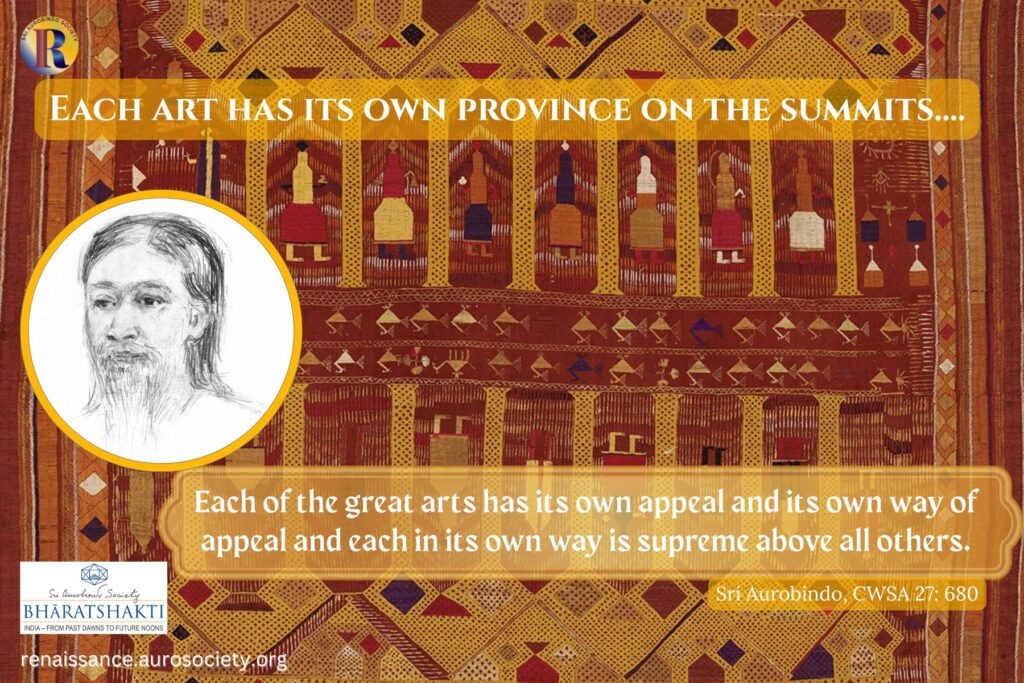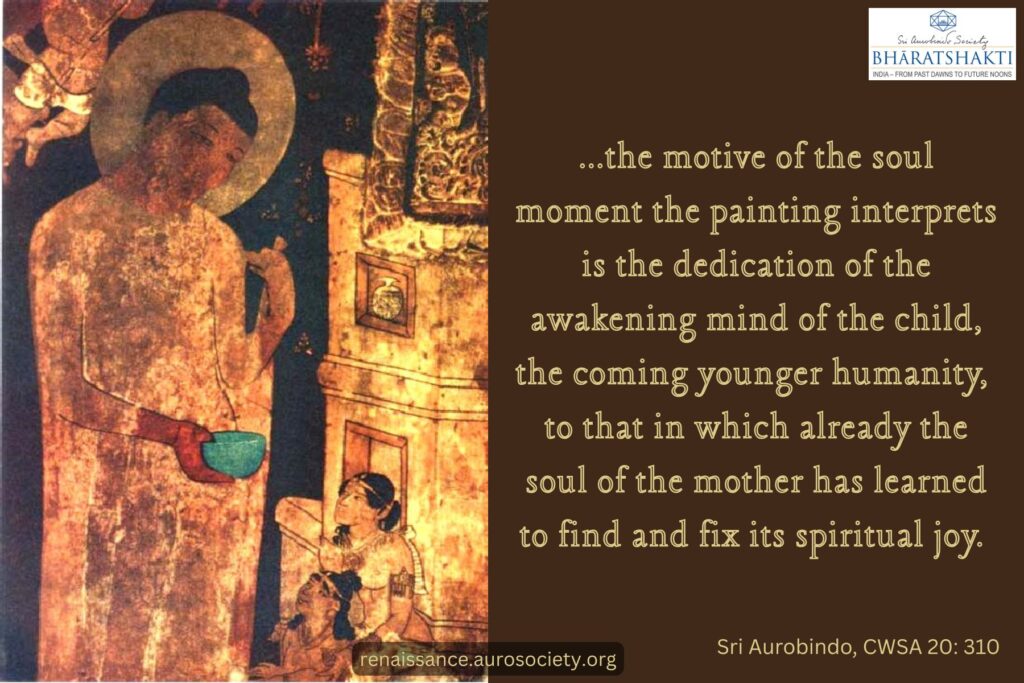Volume VI, Issue 1
Author: Shruti Bidwaikar
Editor’s Note: The author recounts her unforgettable visit to the magnificent temples at Halebidu and Belur, two prime examples of the great Hoysala temple architecture. Read and appreciate how Indian sacred architecture like all Indian art reveals its true meaning and spirit only when ‘seen’ it with an inner vision.
All photographs used below were captured by the author herself during her visit. The short video was captured by the editor. A longer version of this article was first published in New Race: A Journal of Integral Studies (published by SACAR), Volume III, Issue 2, August 2017, pp. 24-30. We are republishing it here with the author’s and publisher’s permission.

Sri Aurobindo’s essays in The Renaissance in India give us a fresh and deep perspective on Indian Art and Culture. As an art critic Sri Aurobindo has set certain parameters using which we can not only appreciate Indian Art but also European Art. At the outset he makes it clear that the lenses used by the critic to see Indian and Western Art are entirely different.
The Western Art’s primary appeal is to the imaginative faculty and focuses mostly on the external details. Indian Art on the contrary “stresses something behind, something more remote to the surface imagination, but nearer to the soul, and subordinates to it the physical form” (CWSA, Vol. 20, p. 262). Indian art reveals the underlying spirit and inspiration in which it was created because it is “identical in its spiritual aim and principle with the rest of Indian culture” (ibid., p. 268).
How is this spiritual aspect depicted in hard granite? How is Spirit captured and revealed through the toughest rock? A visit to the temples at Halebidu and Belur in Karnataka can give us some answers. But first they call for a contemplative observation and a quiet being so that they could reveal their spirit to us.
Watch
Video by Beloo Mehra
Sri Aurobindo cautions us that these places are not to be visited as tourists if we want the art to reveal its true significance to us. He says,
A great oriental work of art does not easily reveal its secret to one who comes to it solely in a mood of aesthetic curiosity or with a considering critical objective mind, still less as the cultivated and interested tourist passing among strange and foreign things; but it has to be seen in loneliness, in the solitude of one’s self, in moments when one is capable of long and deep meditation and as little weighted as possible with the conventions of
material life.
Soul-vision in Granite
During our visit to Halebidu and Belur, we were only in a mood to absorb what the granite figures would speak to us. It was not a romantic walk to the corridors of the past. In the hot summer noon, the hot granite stood the testimony of time, zeal and inspiration of all the artisans who under a great unified spell of intuition carved these temples and figures incessantly for decades.
The first impression after seeing these art works created a “mystery, miracle and magic”, to borrow a phrase from Dr. Kireet Joshi (Philosophy of Indian Art, p. 15). It was mysterious for we were yet to discover what the stones would reveal; it was miraculous because what we saw looked like the work of super-humans. The precision, the variety, the accuracy, the detail and oneness of vision of all the artists were awe-inspiring. It was magical because we are at once transported into that India which indulged in lavish details and leisurely art work. It was India that was ambitious to etch the spiritual into the material.
What would have inspired hundreds of artists for so many decades? We can only imagine! It is also amazing to see that the whole structure emerges as one. All the carvings from the façade to the door of the sanctum sanctorum have a unity of design and show equal dexterity, love and patience of the artists. Hundreds of unnamed artists left for posterity a soul-vision in granite!
Unearthly and Ethereal Halebidu
At Halebidu, we were arrested at the outside itself seeing the multifaceted temple structure. Carved out of the shining black granite it simply felt unearthly.
The first reaction to this beauty in stone was aesthetic. We were caught by the beauty of form, grace of the body postures, accuracy of proportions, and the sizes of the sculptures. And then there were depictions of some story, or one of the great battles of the devas and asuras. But all this leads to one experience: the experience of “akhanda rasa, undifferentiated and unabridged delight in the delightfulness of things” (Sri Aurobindo, CWSA, Vol. 1, p. 440).
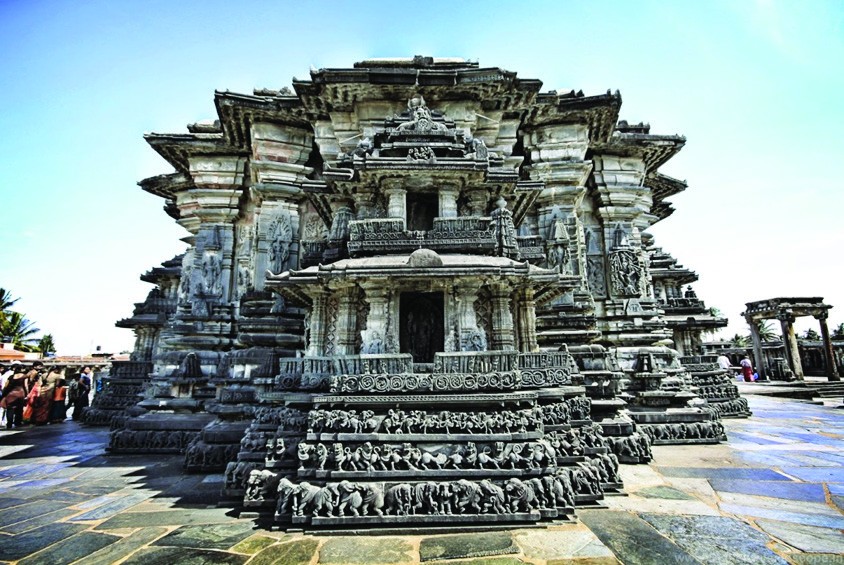
The picture above depicts only one side, one small part of the many structures carved outside of the temple. Architecturally they are not round, square or rectangular in shape. But are polygonal and each side is further cut into more folds so that more surfaces are available for carving. But seen from afar it maintains the unity and symmetry of structure.
From Wonder to Wonder
The carvings on the different walls do not resemble each other but they are of the same style and motivation. The pattern of carving too is the same. Pattern here denotes the depiction of animals and beasts, human beings in their daily activities, evil beings and apsaras, the interaction between gods and human beings and then the cosmic godheads standing right at the top watching over us.
The entire variety of depiction is mind-boggling and aesthetically pleasing. One is just led from wonder to wonder. One can’t help exclaiming in utter admiration of the art and vision that the artists have left for us. But it is not just aesthetic pleasure that we get out of these meditations on the sculptures. In the words of Sri Aurobindo:
For the Indian mind form does not exist except as a creation of the spirit and draws all its meaning and value from the spirit. Every line, arrangement of mass, colour, shape, posture, every physical suggestion, however many, crowded, opulent they may be, is first and last a suggestion, a hint, very often a symbol which is in its main function a support for a spiritual emotion, idea, image that again goes beyond itself to the less definable, but more powerfully sensible reality of the spirit which has excited these movements in the aesthetic mind and passed through them into significant shapes.
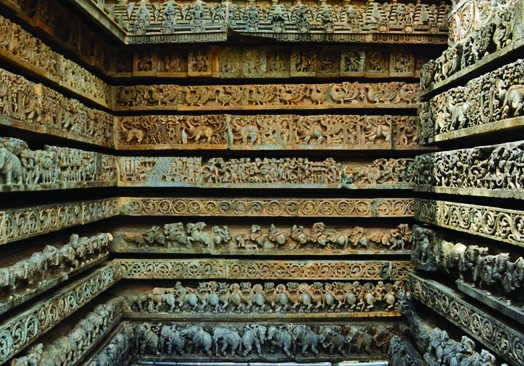
Perfection and Purity
The depiction on one of the niches of the temple portrays the entire life and activities of human beings. They are crowded but distinctly visible; they are opulent but simple in suggestion. No aspect of human life has escaped the eye of the artist. One can almost feel the motion captured in the still stones. They are much more awe-inspiring because such small detail in granite seems almost impossible. Just one distraction on the part of the artist, just one feeling of laziness or boredom would spoil the entire work on the niche.
Surely, the artists who worked on these stones did this in the spirit of sadhana. With a pure heart they worshipped their sacred work. For only when one finds one’s work sacred that one is fully concentrated that he brings out something with immense perfection and harmony. In Sri Aurobindo’s words:
“…sculpture like the architecture springs from spiritual realisation, and what it creates and expresses at its greatest is the spirit in form, the soul in body…”
This spirit was portrayed through beauty, perfection, harmony and purity. While we saw that some of the sculptures were destroyed by some insensitive human beings, we did not, rather could not touch them at all. They were so delicate, so pure and so distant to the normal human consciousness that one dare not malign them by touching.
Rich Details
One after the other, as we walked through statues small and statues large, we could not stop admiring the details attended by the artisans. An ornate human figure stood sentry over the door of the sanctum sanctorum. It was amazing to see the ornaments carved on every inch of this six feet tall figure. From the crown to the details of anklet and even the nail is attended upon.
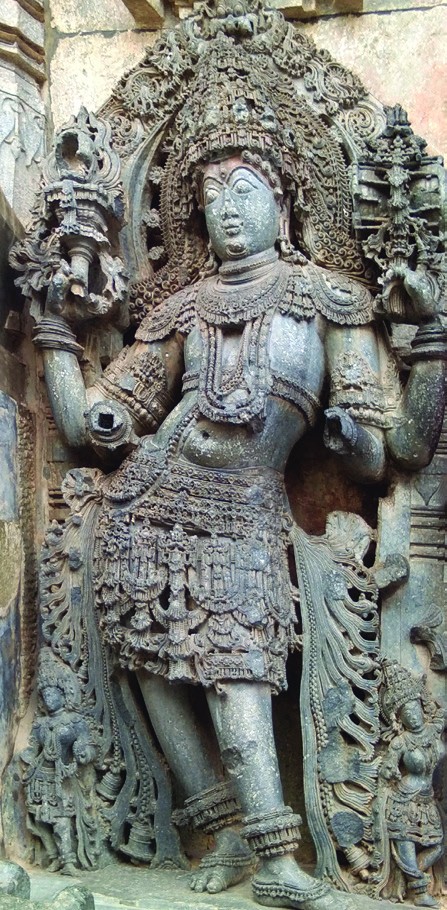
Why would one decorate a dwarpal, a sentry? It was because all human life was considered sacred. No work was small in the eyes of a spiritually realised man. And so the artisans took all the pains to make each detail of each ornament as much as they did for the gods and goddesses.
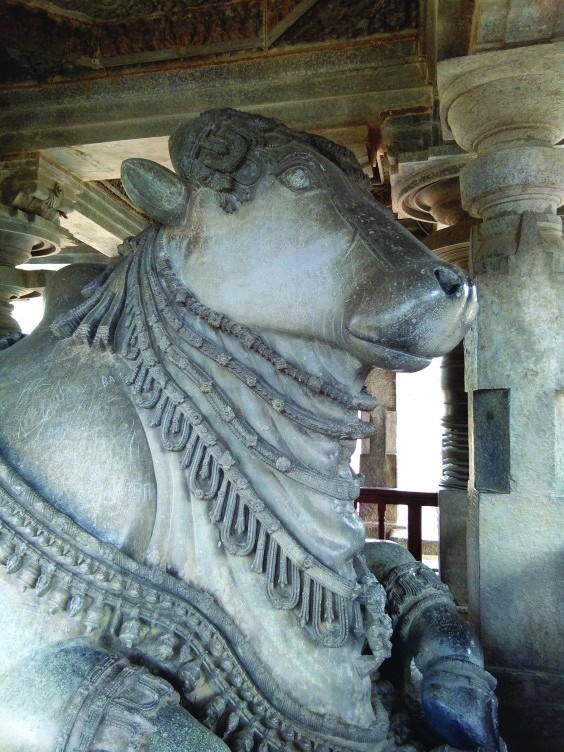
Not only human figures and gods but even in animal figures full attention to detail could be seen. On the huge Nandi Bull, sitting outside the garbhagṛha, facing the Lord, every ornament is judiciously carved. The expression of its face is calm and undisturbed. It looked as if Nandi is eternally meditating on the Lord.
Harmony in Variety
A little further we noticed the small dancing statues on all the walls presenting men and women in graceful postures. One could almost imagine the well-skilled, self-lost devdasis dancing in ecstasy before the Lord. Seeing the dance forms and mudras and postures today, it feels that they have tried to copy and borrow the grace and posture from these living granite statues.
None of the postures, neither the carvings not even the arch around each dancer is the same. But in this variety also there is a harmony. We see human beings in all shapes and forms and moods. On the lower part of the niche the mundane human activities, animals and beasts are depicted. On the upper part, refined human activities like dances and crafts and other sacred art are depicted. A perfect ascent of human consciousness is depicted there in stone.

Opulent Harmony at Belur
We next went to Chennakeshava temple at Belur which was 20-25 minutes away. While Halebidu depicted the earthly and the ethereal on the outside walls of the temple, an opulent and mesmerizing carving caught us by storm inside the Belur temple.
Variety, detail, perfection and harmony characterized each pillar, figure and depiction inside the temple corridors. We wondered why all this this needed inside the temple where one comes for the Lord himself. But here was a specimen to show that God is not only seated in his secret chamber, he also manifests as beauty, perfection and harmony, through human beings, and even in stones.
No two pillars inside the temple are same. Carvings, depictions and events portrayed there are all different. But they complement each other. There is no need for any sameness; it is the diversity which brings in the feeling that all differences can still lead to harmonious beauty. The temple at Belur was a perfect example of satyam shivam sudaram.
The apsaras in various postures seemed to be hanging from the ceiling in perfect balance. They could only be seen when light was flashed on them. We almost felt that such perfection could not have been portrayed even on paper. And yet the artists have achieved this in granite.
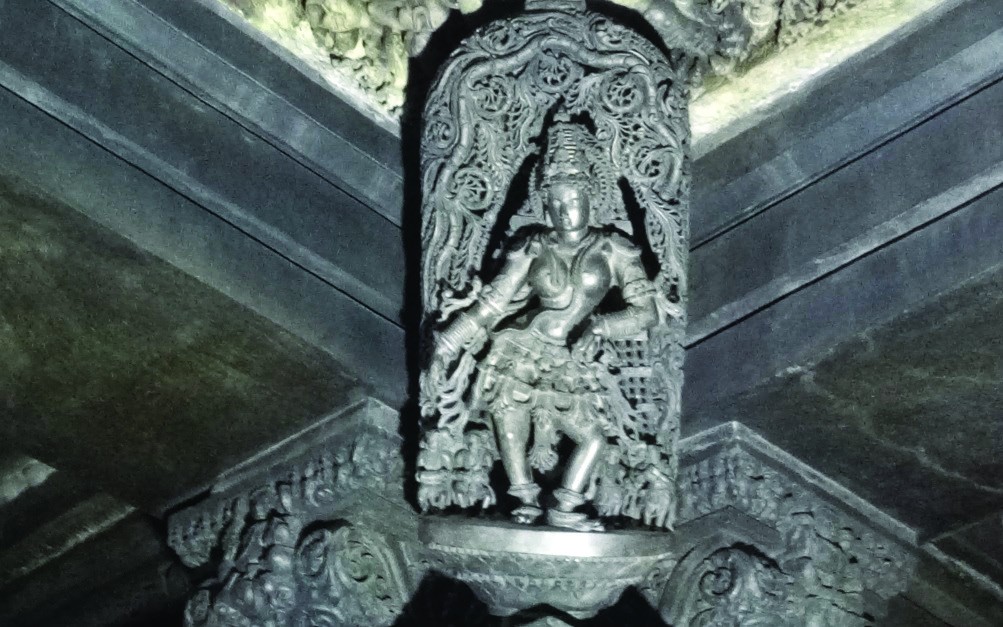
Ideal of Grace
These depictions looked unearthly or perhaps represented the perfect human body, activity and grace. Such has been the ideal of grace set before Indian men and women. Not an outward show, but a body held by an inner poise reflected in the grace of the posture and balance of features and expression. There was much to learn from these super-human figures.
The depictions of gods and goddess was another aspect which completely left me spellbound. I wanted to capture each figure in my memory or at least in camera. It was interesting that in both the temples, especially in Halebidu, Vedic as well as Pauranic deities were depicted in every trait and character.
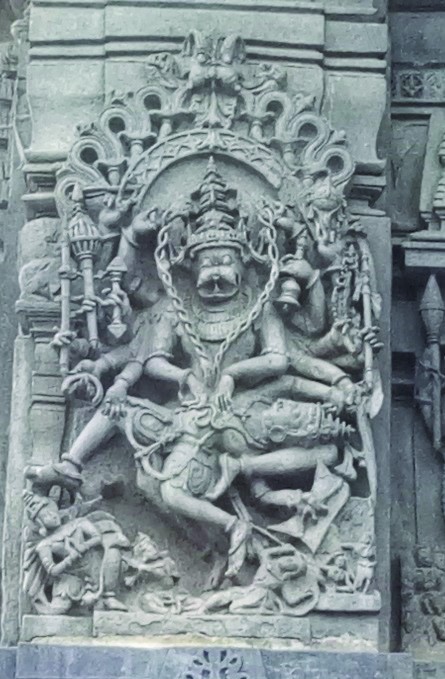
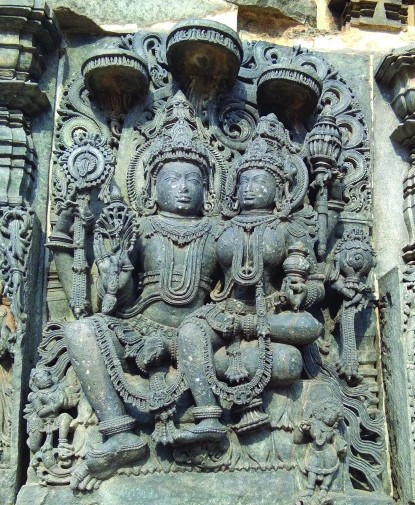
I was amazed to observe that a sculptural beauty was placed even in the smallest available corner space of the temple exterior. These are sometimes not even visible clearly, but the artists did not leave the space empty because of the difficulty of vision. Perhaps they were spiritually guided by the fact that Divine is in every little corner and so they chose to place the Divine everywhere. While a few critics take objection in figures of gods and goddess, Sri Aurobindo answers them fittingly,
The gods of Indian sculpture are cosmic beings, embodiments of some great spiritual power, spiritual idea and action, inmost psychic significance, the human form a vehicle of this soul meaning, its outward means of self-expression; everything in the figure, every opportunity it gives, the face, the hands, the posture of the limbs, the poise and turn of the body, every accessory, has to be made instinct with the inner meaning, help it to emerge, carry out the rhythm of the total suggestion,…
Being One-hearted
This visit to Halebidu and Belur was not only an education in art and history, but it was an odyssey in the inner being. Like in poetry, so in any other art, I realised that unless we are sahrydaya, one-hearted, one consciousness and pure within, we will only remain mesmerized with the outer beauty of these figures.
But the more we remain quiet we almost feel that each stone is speaking to us. Recollecting those moments even today I am led to tranquility and peace. We have to make our being as tranquil as the artisan so that we could enter the purity of the atmosphere in which the structures were carved with perseverance, patience, devotion and love.
It was a selfless offering of the artists because nowhere are their names written or mentioned. Their carving perhaps was their mediation and puja and that alone was their offering. While they took decades of incessant work to pour soul into stone, we can perhaps spend a day or two invoking them to reveal the same soul to us. For the first time I understood that the inner eye was needed to appreciate what was carved with an inner vision.

Also read:
Indian Sacred Architecture and the Original Oneness
~ All photographs by Shruti Bidwaikar
~ Video and post design by Beloo Mehra

